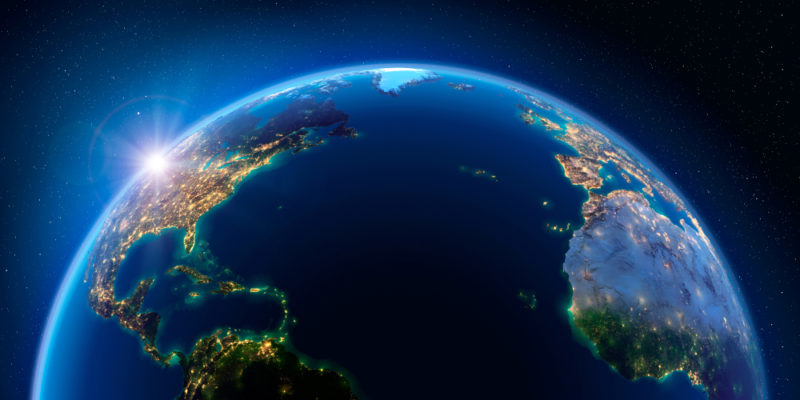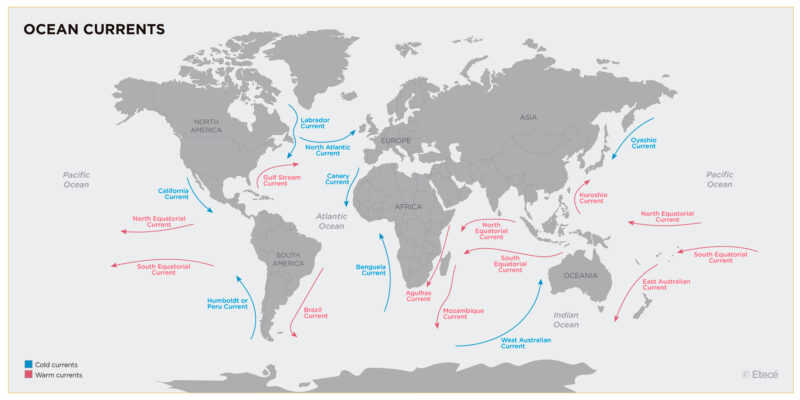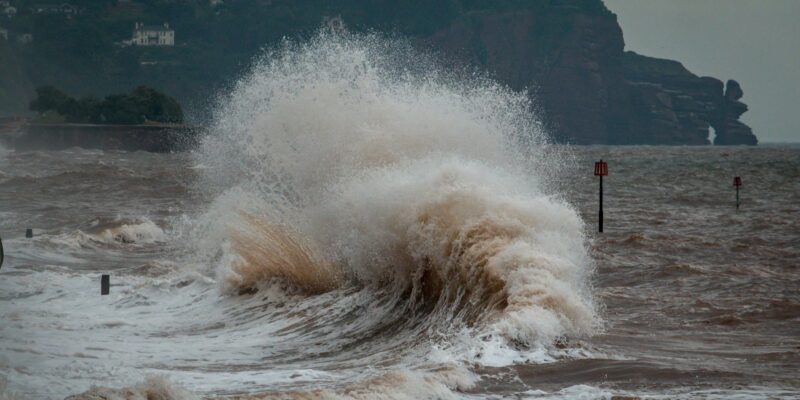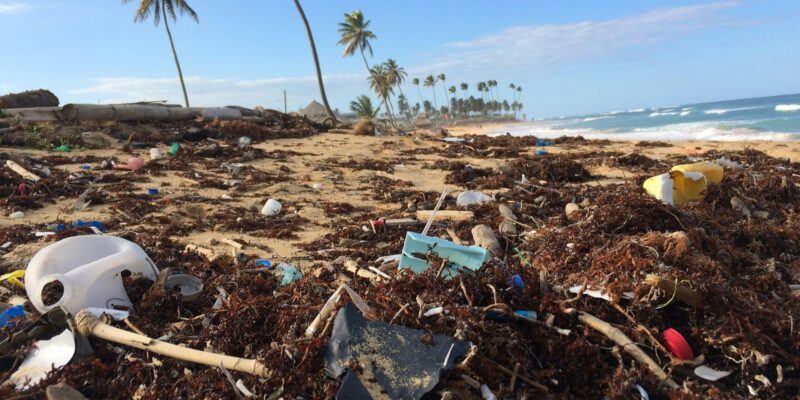We discuss what oceans are, how many there are, and describe their characteristics. In addition, we present their extent, environmental threats, and more.

What are oceans?
Oceans are large bodies of salt water separating two or more continents. They cover most of the Earth's surface (71%) and contain over 312 million cubic miles (1.3 billion km3) of water, accounting for 97% of the Earth's water supply.
There are five major oceans on Earth: the Pacific, the Atlantic, the Indian, the Southern, and the Arctic. The surface area of all of them combined is estimated at 139 million square miles (361 million km2), with the average depth reaching 12,800 feet (3,900 m). The deepest point is located in the Mariana Trench, in the Pacific Ocean, at 36,062 feet (10,992 m) below sea level.
It was in the ocean that life began. Today, oceans are home to an extraordinary biodiversity ranging from tiny single-celled organisms to large mammals including the blue whale, the largest animal on the planet. In addition, the aquatic ecosystems populating the oceans constitute a vital resource for humans.
Oceans are a key element of the water cycle, and are essential for regulating Earth's climate. They also store large amounts of carbon dioxide and release water vapor, which in turn becomes precipitation reaching every corner of the planet.
- See also: Water cycle
Ocean facts
Oceans have the following characteristics:
- They are made up of salt water.
- They cover 71% of Earth's surface.
- They contain over 312 million cubic miles (1.3 billion km3) of water, and have an average depth of 12,800 feet (3,900 m).
- They account for 97% of the Earth's water supply.
- They are home to a large number of species and a source of extraordinary biodiversity.
- They are key to the water cycle and climate regulation.
- They provide resources for humans.
How did oceans form?
Oceans formed from the separation of the continents over geologic time. 200 million years ago, all present-day continents were joined together forming a single supercontinent called Pangea. The only ocean that existed at the time was Panthalassa, which surrounded Pangea.
As the continents began to break apart, the oceans were formed as we know them today. Thus, the separation of Africa, Europe, and America caused the Atlantic Ocean to form; that of Africa and Oceania formed the Indian Ocean; near the North Pole, the Arctic Ocean formed, and close to Antarctica, the Antarctic Ocean. The rest of Panthalassa came to form the Pacific Ocean.
Composition of ocean water

Ocean water is made up of salt water. It is composed of 97 % H2O with the rest being dissolved solids, such as sodium chloride (the most abundant, it accounts for salinity), magnesium chloride, sodium sulfate, calcium chloride, and potassium chloride.
The salinity of ocean water is due to various factors, including salts carried by rivers flowing into the sea, high evaporation rates causing increased concentration of salt, as well as volcanic eruptions occurring in the depths.
This explains why not all oceans have the same salinity levels. In warmer oceanic regions with higher evaporation rates, or in areas where rivers flowing into the oceans transport larger amounts of sodium chloride, ocean water is saltier.
Ocean temperature
The temperature of oceans varies with location, season, and depth.
- By location. Ocean areas lying in warm regions have warmer waters. In regions near the equator and the tropics, ocean temperatures can rise to over 86 °F (30 °C), while in polar regions ocean water can be below freezing point.
- By season. Ocean water temperature increases during the summer months and decreases in the winter. In colder regions, during the winter months, water temperature can drop below 30.2 °F (-1.9 °C), the freezing point of salt water, turning into ice.
- By depth. As depth increases and the influence of the sun's heat decreases, ocean water temperatures tend to drop. In depths with no sunlight, temperatures are usually close to the freezing point of 30.2 °F (-1.9 °C).
Ocean flora and fauna
The flora and fauna of oceans are determined by the characteristics of the environment where they appear.
- Intertidal zone. This is where the sea meets the land. Twice a day, the sea rises due to tides, submerging parts of the coast, and twice a day it ebbs away, revealing larger areas of unsubmerged beach. High levels of sunlight and nutrients, along with abundant oxygen, make the intertidal zone a biologically rich environment. Clams, snails, and crabs abound, as well as all types of plants, including spartina and algae.
- Open ocean. This is the most densely populated zone in the ocean by animals of all types. Ecosystem complexity decreases with depth. The diversity of animal species is extraordinary: from small crabs to sharks and whales make up highly-developed ecosystems. Phytoplankton is the ocean’s most abundant plant species, which is crucial to oxygen production on Earth through photosynthesis.
- Ocean floor. In shallower, warmer ocean waters with abundant sunlight, organisms such as seagrass beds and coral reefs thrive. On deeper ocean floors, between 20,000 and 30,000 feet (6,000 and 9,000 m) deep, the lack of sunlight, high pressure, and low temperatures are major constraints to the development of life. Plant and animal life in these zones have evolved adaptations to survive in these conditions. An example of this are bioluminescent animals like lanternfish, which produce their own light.
Ocean currents

Differences in water temperature cause ocean currents to form. These are water flows that are in continuous movement within the oceans. Equatorial and subtropical regions have warmer water than polar regions. These differences in water temperature drive ocean circulation.
Ocean currents may be warm or cold:
- Warm currents: Such as the Gulf Stream and the Kuroshio Current, they transport warm water from equatorial regions to higher latitudes. This affects the climate in coastal areas, and may lead to significant variations in local temperatures.
- Cold currents: Such as the California Current or the Humboldt Current, they transport cold water from high latitudes to equatorial regions, and can significantly influence temperatures and precipitation in coastal areas as they pass through.
Tides

Ocean water is never still, but is in constant motion due to tides. Tides are periodic oscillations of the sea level caused by gravitational forces exerted by the Moon and the Sun over the Earth. This oceanic phenomenon is manifested in the regular rise and fall of sea surface.
The gravitational interaction of the Moon and the Sun generates two main types of tides: high tides, which correspond to the rise of the sea surface, and low tides, characterized by the fall of the sea level. These variations occur twice a day in most coastal regions.
Ports and coastal areas usually have tide tables providing detailed information on the estimated tide times at a given location, which is of great importance for navigation, fishing, and other ocean-related activities. Tides also play a crucial role in the ecology and geology of coastal areas by determining the distribution of marine species and impacting coastal erosion.
Natural disasters and ocean hazards

A frequent natural disaster associated with the ocean are hurricanes, a meteorological phenomenon characterized by strong winds and heavy rainfall. Hurricanes can cause devastating damage to coastal areas and marine ecosystems. These extreme events are fueled by the evaporation of ocean water, and they usually increase their intensity as they move over warmer waters. Hurricanes only occur in ocean areas lying in warm climates.
Tsunamis, in turn, are triggered by earthquakes occurring in the oceanic crust or in the continental crust near the coasts. These events can produce giant waves traveling at high speeds through the ocean which, upon reaching the coast, may cause massive damage.
Ocean pollution

Ocean pollution is a global phenomenon that occurs when harmful substances and waste enter marine ecosystems. Major ocean pollutants can be classified into two broad categories:
- Chemical pollution. Toxic chemicals such as heavy metals (e.g., mercury and lead) as well as pesticides and herbicides are the main chemical pollutants in the ocean. These may derive from land-based pollution sources, such as agriculture or industry, or from marine pollution sources, such as ship discharges and oil drilling activities on continental shelves.
- Plastic pollution. The accumulation of plastic debris in the oceans is a growing concern. Microplastics (tiny plastic fragments) and macroplastics (such as containers and abandoned fishing nets) threaten marine life and affect water quality.
At present, it is estimated that five large garbage patches exist in the oceans, that is, massive accumulations of trash floating in the water. The largest, lying in the Pacific Ocean, covers an area of about 618,000 square miles (1.6 million km2) and contains around 80,000 tons of plastics.
In response to these environmental issues, the United Nations has adopted international conventions and agreements. Among them is the MARPOL Convention (International Convention for the Prevention of Pollution from Ships), which regulates the discharge of residues containing hazardous substances from ships into ocean waters.
Likewise, the United Nations Convention on the Law of the Sea (UNCLOS) establishes general principles for protecting and preserving marine environments.
Explore next:
References
- Aquae Fundación. (2021). Tsunamis: qué son y cómo se generan. https://www.fundacionaquae.org/
- Naciones Unidas. (2021). El plástico, que ya ha atragantado nuestros océanos, terminará por asfixiarnos a todos si no actuamos rápidamente. Noticias ONU. https://news.un.org/
- National Geographic. (2010). Océanos. https://www.nationalgeographic.es/
- Núñez, S. (2022). Qué son las mareas y por qué se producen. EcologíaVerde. https://www.ecologiaverde.com/
- Organismo Internacional de Energía Atómica. (s.f.). Contaminación del mar y las costas. https://www.iaea.org/
Was this information useful to you?
Yes NoThank you for visiting us :)